WITHOUT PEER
Leagues ahead – the unrivalled restaurants of our port cities
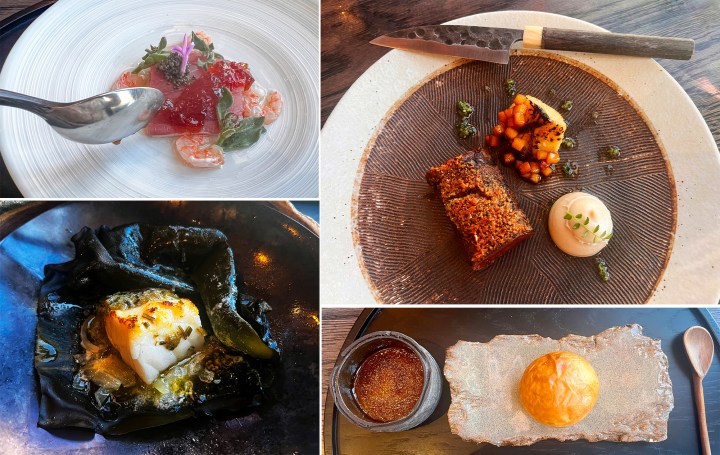
Visits to our two biggest port cities gave us the chance to experience the finest restaurants each metropolis has to offer. In Part One of this two-part series, we’re in Cape Town and disembarking from a cruise ship to head for FYN.
Travel plans take you on long roads or aboard great ships to big cities where fine restaurants await that you normally cannot get to, given where you live in your Karoo refuge. It’s the strangest thing about working for online newspapers: you can be anywhere in the world, and the things you write about can be far away. But life somehow finds you and takes you there anyway.
The Fourth Estate brings you other unlikely things.
You may find yourself on a cruise ship with a famous chef on board, and when you get to Cape Town you may find yourself with a Port Day. A kind of day you have never thought about until, suddenly, you had one, and had to decide what to do with it.
You may find yourself with another sort of a “port day” in Durban only weeks later, thanks to your wild, wonderful youngest niece getting married. And walk the entire length of the famous beachfront promenade, all the way to the entrance to the harbour, where once you sailed into the Indian Ocean on board P&O Canberra. You stand there and picture the grand old liners cruising in, and a day later cruising out, and wonder what all the people on board did with their Port Day in Durban.
My two days in these old port cities took me to two of the country’s finest restaurants. No also-rans here. These two are the pinnacle of the cream of the crop, the very best that either of these metropolises has to offer.
Each is owned and run by a chef with a razor-clear intent. They know exactly what they want to go on the plate. Their two styles have nothing in common other than the aim of the very best they are capable of. And each has many peers, many of them also among the finest in the land, but none, and I mean none, whose food is better than theirs.
We’ll get to the Durban restaurant we’re talking about next week, but for now, let’s disembark and take a long walk through Cape Town to have lunch at Fyn.
It’s hot and sunny in the Mother City and during the night MSC Poesia has moved from B to E berth, the cruise terminal, which had been occupied by another cruise ship when we docked at 1am. My Sunday Times colleague and I have arranged to have lunch at Fyn restaurant in the CBD, where Peter Tempelhoff is expecting us with a menu of food paired with too many wines. We know we’ve gone a bit mad, because the lunch will last until around 4pm, and we have a big, important dinner on board hosted by chef Reuben Riffel tonight. But in our line of work you don’t miss an opportunity like this. Belt-tightening is put on hold.
It’s also strange to have journalists from two leading newspapers sharing exactly the same lunch with precisely the same wines, course by course. We each wonder what the other is thinking and will be writing. We pass comments back and forth, exclaim at this, ponder about that, disagree about the other.
Tempelhoff assigns a treasure to attend to us. Dustin Blencowe must be one of the most attentive and informed, yet utterly nice, waiters there is in the industry. But almost every other staff member in the house brings our food or wine at some point. It’s a thing about Fyn and Peter’s other restaurants (there’s Ramenhead downstairs, its cousin at the TimeOut Market at the V&A Waterfront, and Beyond in Constantia). It’s as if the whole family wants to pop in and say hi at some point during the afternoon, putting a dish in front of you, introducing a wine or topping up a glass. As at Beyond, it’s refreshingly casual here despite the big-guns food.
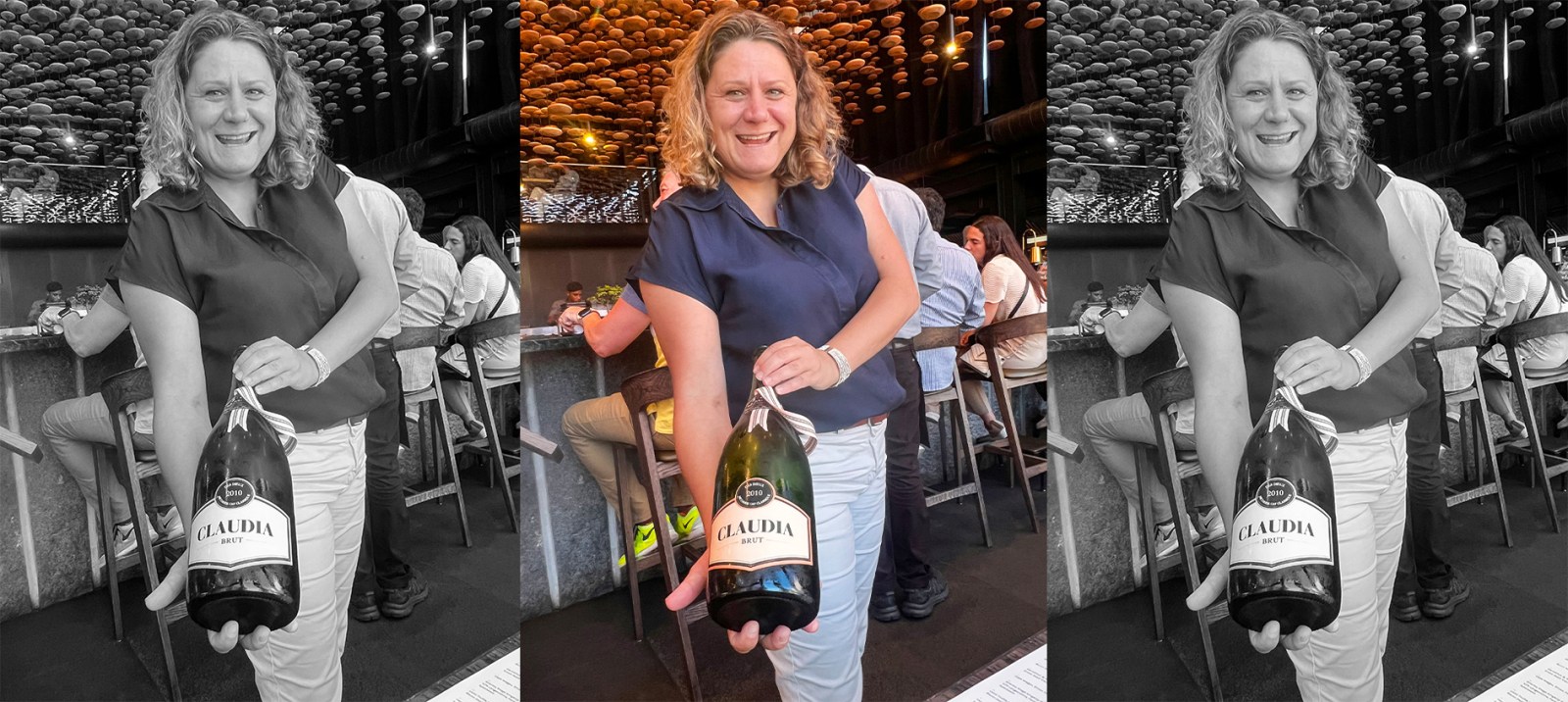
The fabulous Jennifer Hugè. (Photo: Tony Jackman)
An utter delight is that my favourite sommelier, though she is more than that at Fyn, is here. I first met Jennifer Hugè on the very day that the original La Colombe at Constantia Uitsig opened for its first-ever lunch, circa the mid-nineties. She bestowed her bubbling French charm all over us then, as she has for tens of thousands of diners over the decades, and here she is, enchanting us at Fyn. She introduces most of the wines to us, but both she and Peter usher in other crew members to enlighten us as to what is being poured. She keeps front-of-house oiled and sharp, yet there’s no sign of stress on her. Third key team member, Ash Moss, may be somewhere around but I don’t spot him.
Kitchen and dining room are one here. The arresting design by Tristan du Plessis suggests the clean lines and pristine monochrome hues of Japan, but offsetting that with what seems to be hundreds of over-sized wooden African beads hanging disproportionately from the very high ceiling. If you began to count the beads, you’d soon give up. It’s an exciting space to be in. The cuisine follows the same path: Japanese in backdrop and style, South African in substance. This seems to me to be the essence of Fyn.
You may think that Tempelhoff “does Japanese”, and find this anachronistic for such an influential chef in our showcase city, but look at the ingredients and the clues lead you to the fish of our seas and the creatures, leaves and spices of our land, from our West Coast and the Kalahari to Mozambique and Madagascar.
Dustin starts us off with a Fyn martini, citrusy Japanese gin with sansho peppercorns and lime bitters.

A bit of drama at the table to serve Madagascan black caviar, Africa’s finest and only. (Photos: Tony Jackman)
And there is theatre at Fyn. The scalp of a white skull is removed to reveal its innards of Madagascan black caviar in a tiny bowl. Exquisite morsels have been placed on the gorgeous halfmoon black plate before us. There are four delights demanding your salivation: blue crab, abalone, yellowtail nigiri and a sliver of tamagoyaki egg roll.
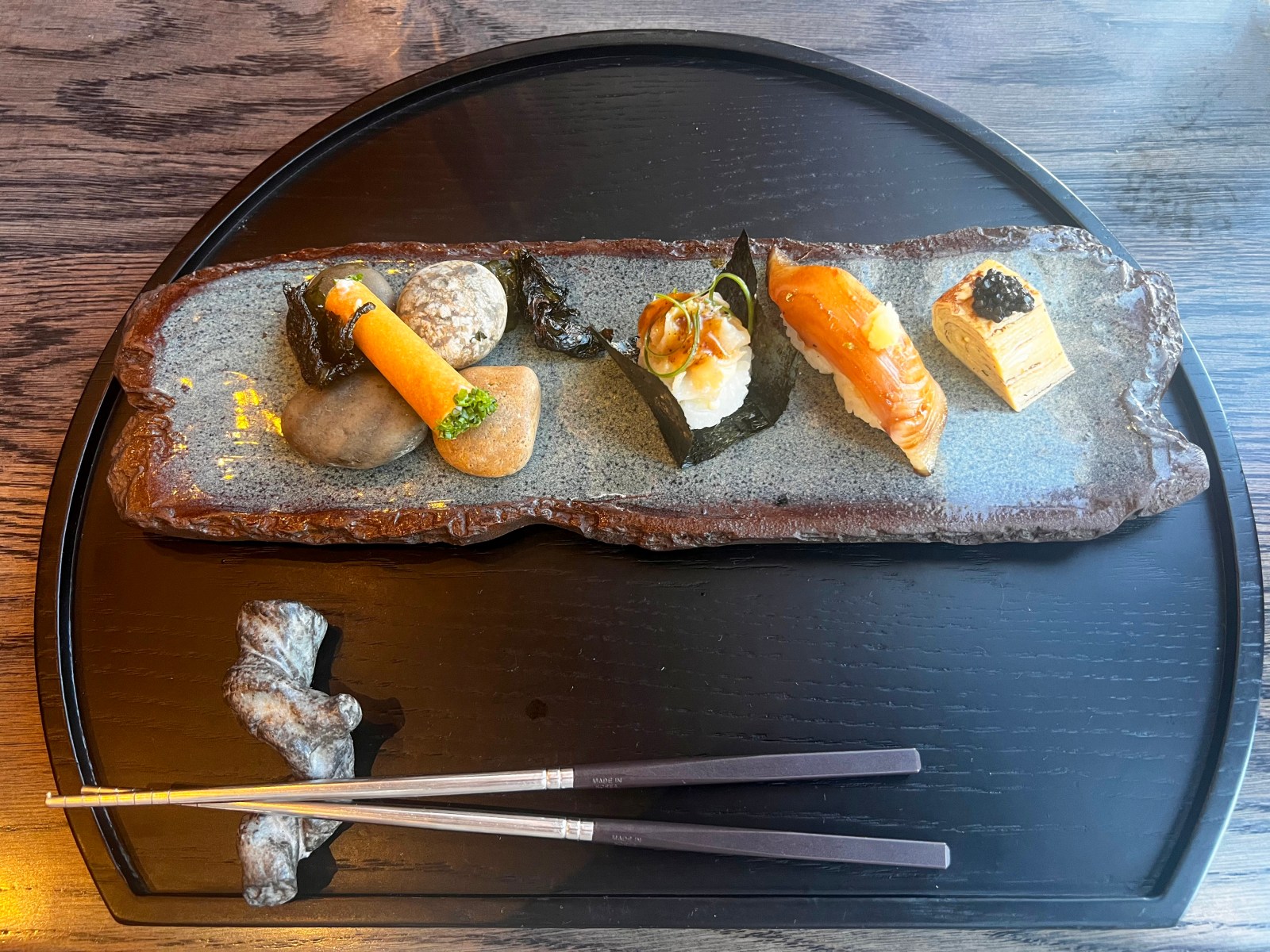
Blue crab, abalone, yellowtail nigiri, and a sliver of tamagoyaki egg roll, topped with Madagascan caviar. (Photo: Tony Jackman)
On the left, on a bed of pebbles, is a slim but crunchy cylinder of pastry with tufts of bright green at the ends. Inside it are morsels of Mozambican blue crab with apple, lime and basil. And this single bite, one of four in front of you, has a story. Tempelhoff says we should all be eating blue crab, and “the more the better”.
“It’s become a bother to coral reefs with the onset of global warming,” he says, so eat blue crab and do the planet a favour.
A bite of the astoundingly soft Lamberts Bay abalone with its soy-mirin kaeshi dressing, and your feet are in the city but your mind is on the beach. Snap back to Earth and it’s the turn of the neoteric nigiri with aged Japanese shoyu-style soy. It’s yellowtail and has been pan-seared, the waitress tells us. “Neoteric” seems to tell you all sorts of things. It can mean new or modern, boisterous or clamorous, lavish or powerful. Most of those words are too strong for something so delicate, so I think we are to understand it as a new take on these two-finger delights.
The final soupçon of a sliver of tamagoyaki rolled omelette pops into your mouth. The tiny mound of black pearls on top is Madagascan caviar – “Africa’s first caviar,” our waitress tells us. This quartet is all on one plate, four harmonious yet individual heralds of what is in store.
More theatre is here as a golden milk bun is presented on an extraordinary rectangular but irregular platelet. Alongside it is placed a grey circle of intrigue: an upside-down ramekin. You are to turn it over the way you might do if you were testing whether cream is whipped thick enough.
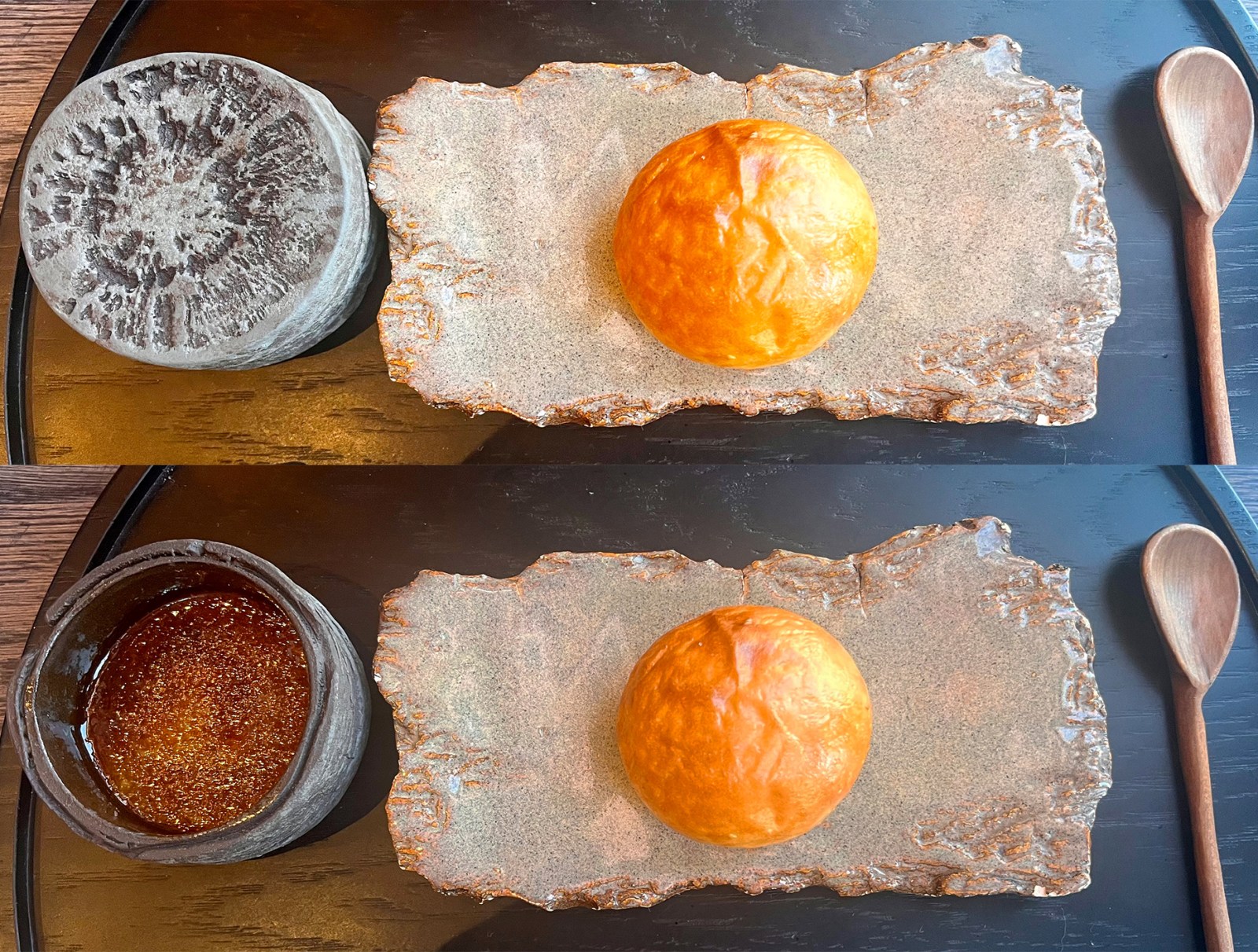
Burnt mushroom crème brûlée with a hokkaido milk bun. You turn the grey ramekin upside down to find the wonders within. (Photo: Tony Jackman)
It is a Tempelhoff classic: a savoury crème brûlée of sorts, a burnt mushroom custard that ultimately has you gouging into the bottom of the bowl to find more. I first tasted this when I was initiated into his way with food at the Greenhouse at the Cellars-Hohenort in Constantia. There’d be a lynching if it were to disappear from his menu. The accompanying Hokkaido milk bun/shokupan is impossibly soft and I rub the bread into every possible cavity of the ramekin in the unrequited hope of one last taste.
Then comes a sashimi course. Three slivers of yellowfin tuna are guarded by a quartet of tiny nylon shrimps dressed in hot olive oil, and despite the modesty of this dish the minuscule crustacea are one of my strongest memories of this meal, strangely since they are so little you could miss them if you blinked.
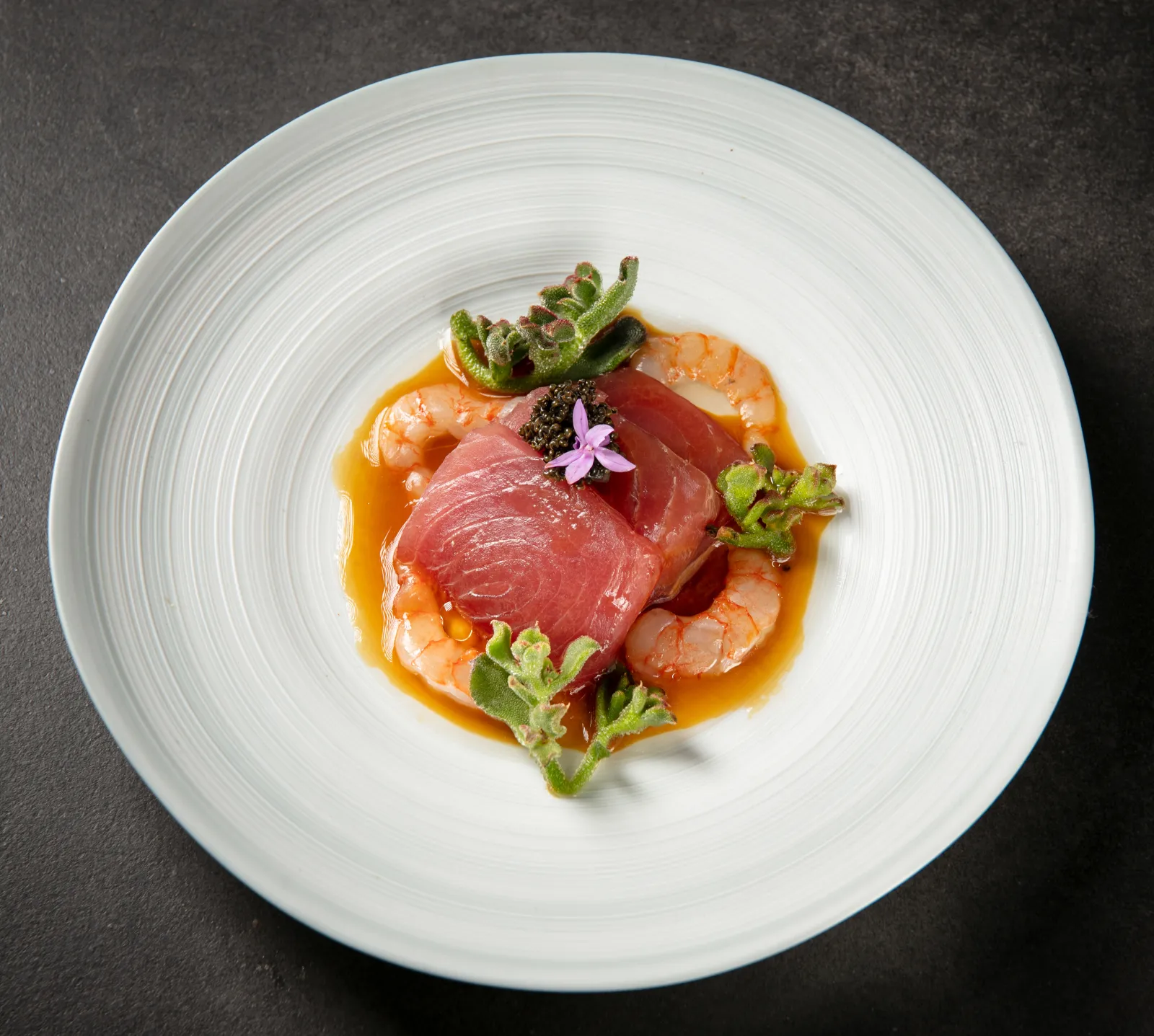
Yellowfin tuna with nylon shrimps dressed with hot olive oil. (Photo: Supplied)
And here is a spoonful of a signature ponzu, this time as a jelly, another Tempelhoff favourite that I remember first encountering at the Greenhouse. Garnishing the dish are sprigs of soutslaai (literally salt salad) cultivated in Hout Bay, and what look much like caviar but are actually tonburi, described on the menu as “grass seed caviar”, which are the dried seeds of the summer cypress tree, sometimes called land caviar or mountain caviar.
Slivers of Ken Forrester’s wagyu beef are served with salt-baked carrots from Meuse Farm in Hout Bay, which also cultivates the soutslaai served with the previous dish.
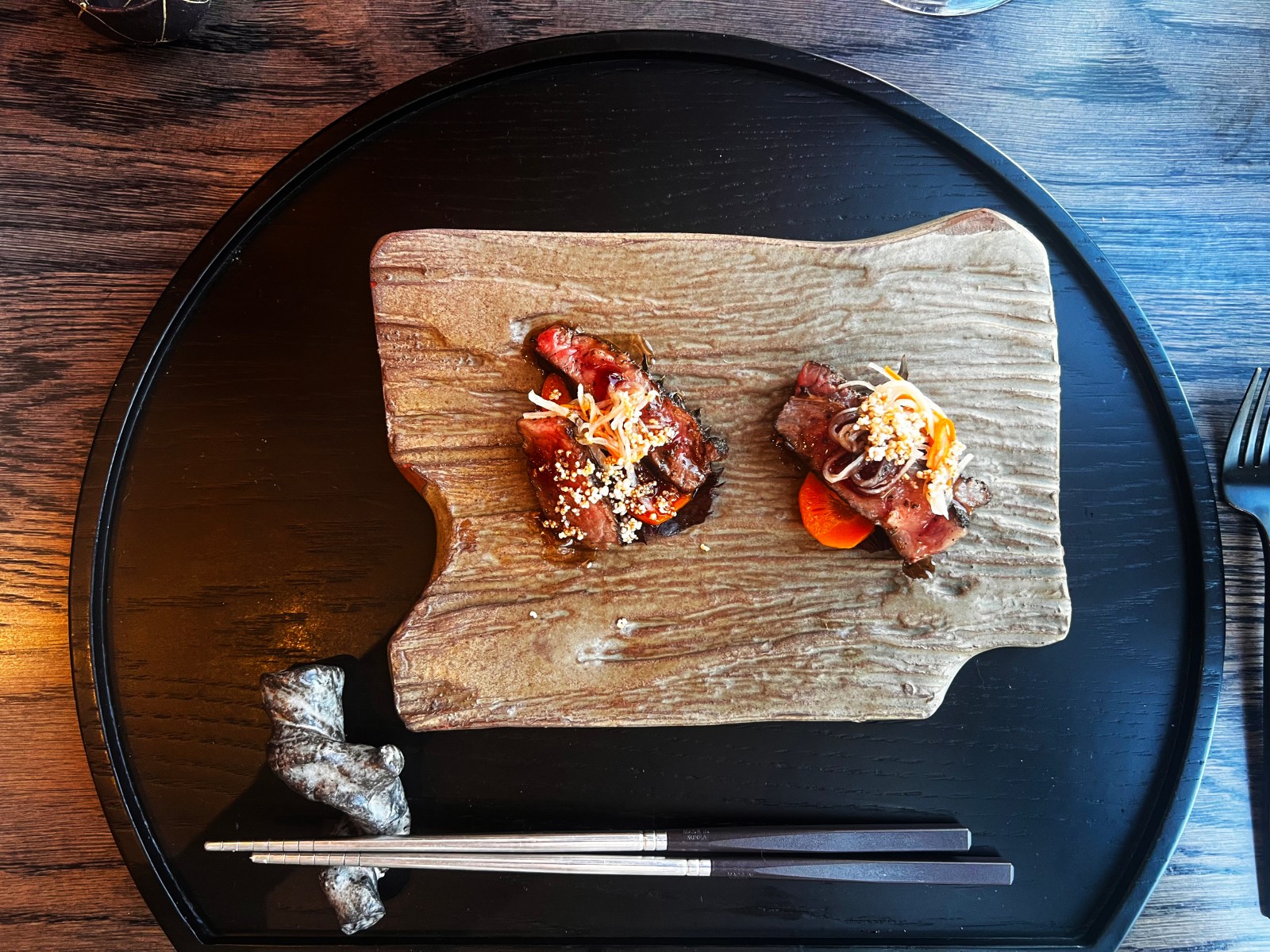
Ken Forrester wagyu beef. (Photo: Tony Jackman)
We’re about halfway through and we’re mindful of Reuben’s dinner tonight. Jennifer Hugè and her team are not showing any reticence in pouring us not only the pairing wines on the menu but often a second one “for you to compare and tell me which you think goes best”. I readily admit to not paying a great deal of attention to wine pairings, because I rarely find that the one proferred by a sommelier is markedly more than a fair match for what I’m eating. But the gregarious and delightful Hugè picks wines every time that are an undeniable match. And the same is to happen when I venture to Durban not long afterwards, but come back here next week for that. (See the end of the story for a list of the wines on the pairing menu.)
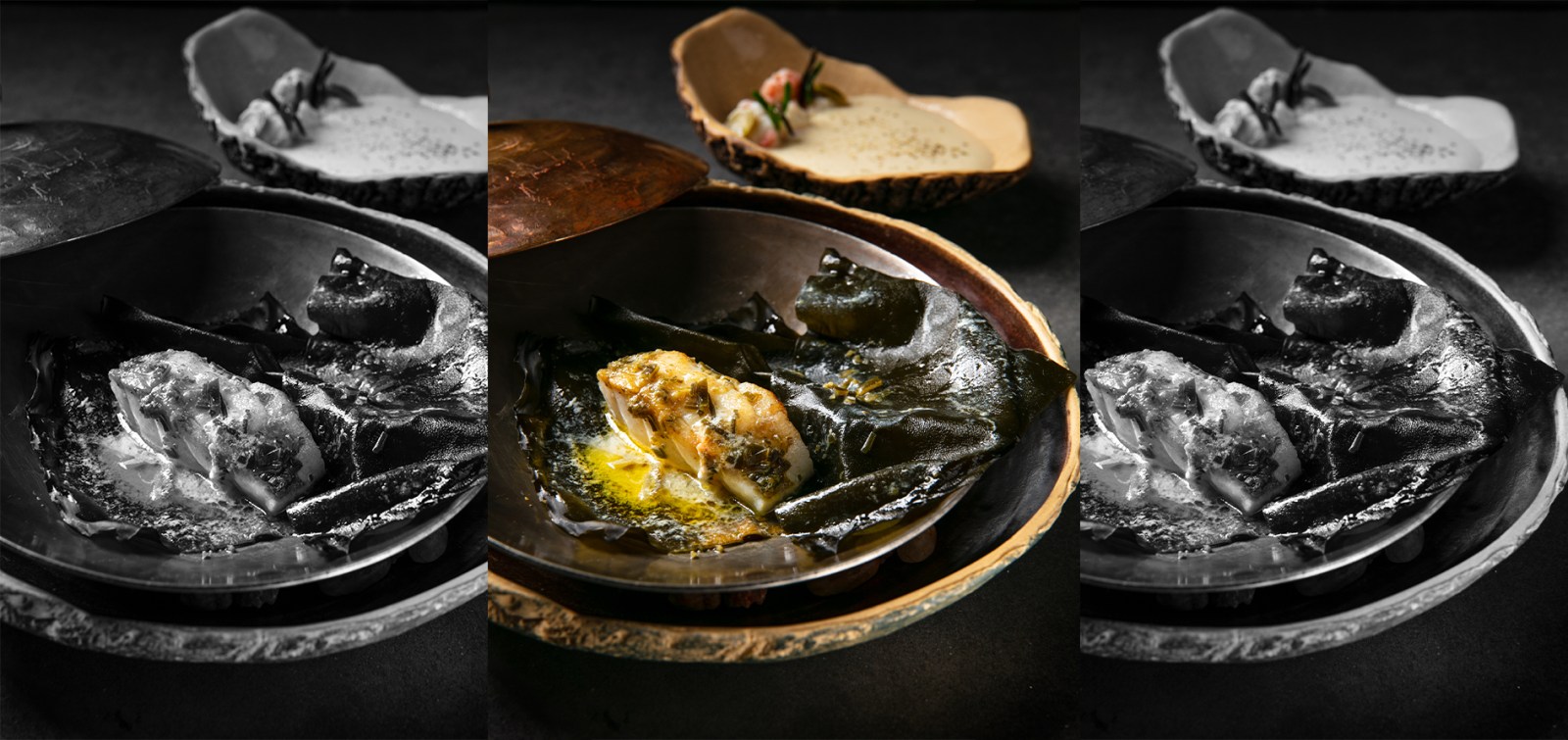
Line-caught kingklip from the Agulhas shelf that has been baked in kelp with yuzu butter, and a KZN langoustine. (Photo: Supplied)
A cunningly mysterious little black parcel of Misty Cliffs kelp is unmasked to reveal a beautiful caramelised nugget of line-caught kingklip from the Agulhas shelf that has been baked in the kelp with yuzu butter. In a tiny shell-bowl alongside is a succulent KwaZulu-Natal langoustine mounted with an espuma-gun shot of koji and sake cream. This, says our world-class waiter, is to “show how we use seaweed as a cooking technique”. Somehow the butter inside the kelp has done its work to caramelise the fish within. As instructed by Dustin, we mix the koji and sake cream sauce and pour it over the fish before eating it.
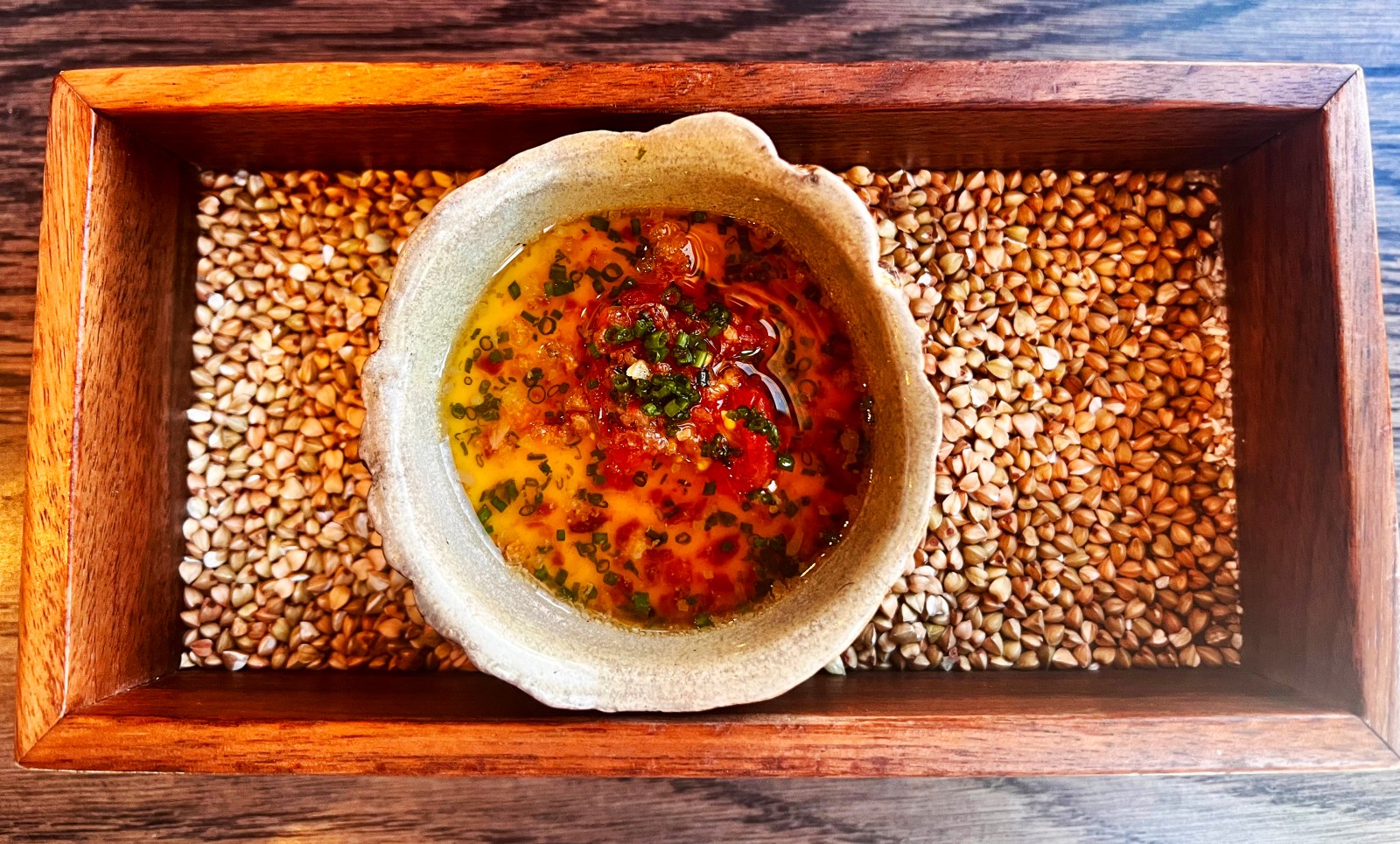
Chawanmushi, a sort of soft, fishy custard. (Photo: Tony Jackman)
The bright bowl-in-a-box that comes next was not on the menu: chawanmushi, a soft, fishy custard which Peter says is “a polarising dish generally”. Many don’t take to it, but I savour every morsel. Tomato, truffle and bacon dust work their magic on a dish that seems to be intentionally understated, given the flavour peaks everywhere else.
We choose artisan knives by Anton Kock for the Kalahari springbok loin with its crust of hazelnuts and pancetta crumbs, with silken salt-baked celeriac, elegantly smoky, dotted with cubelets of Elgin apples, served with a Cape mountain sage and springbok reduction.
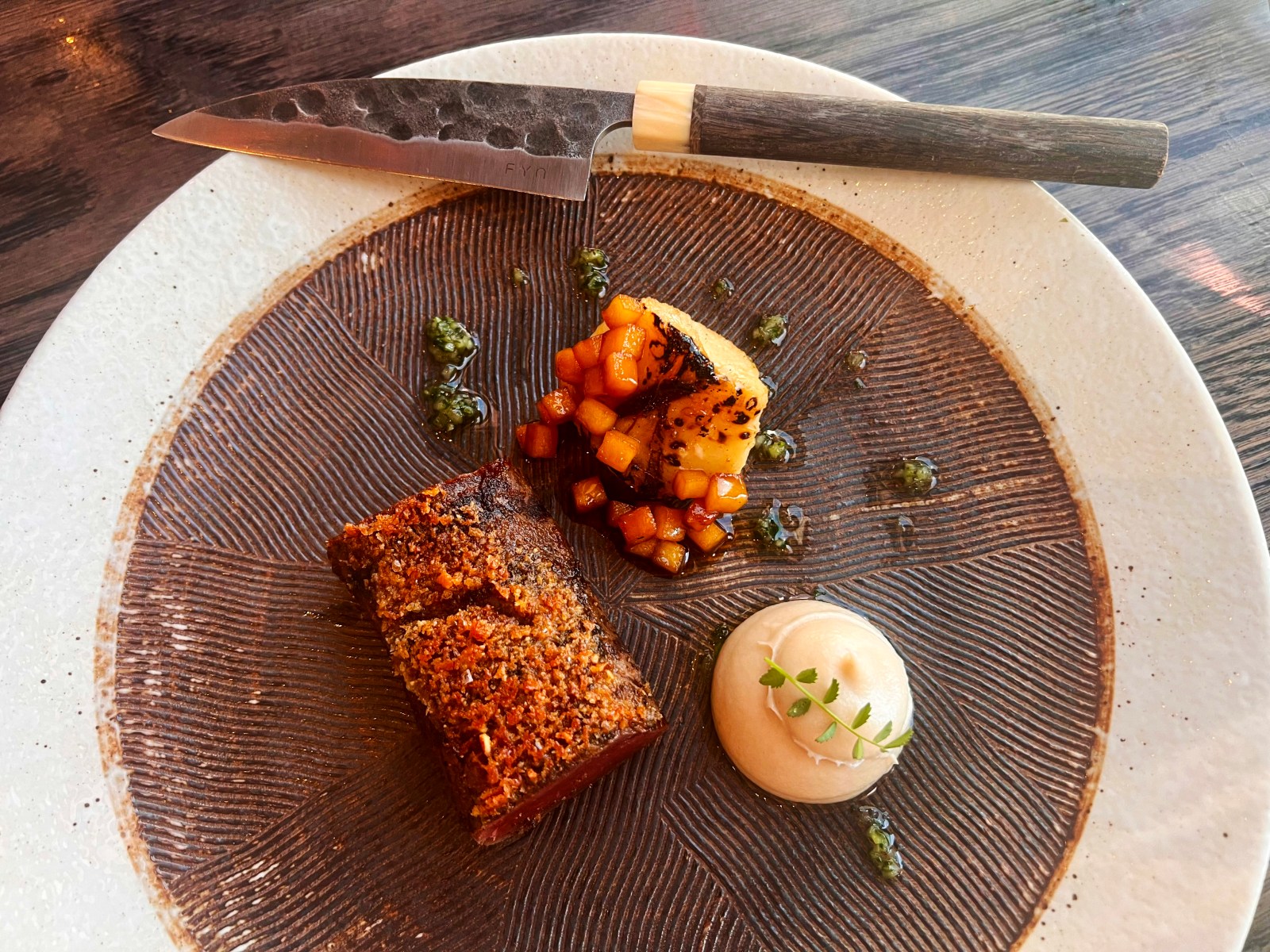
Kalahari springbok loin with a crust of hazelnuts and Richard Bosman pancetta crumbs. (Photo: Tony Jackman)
Even Peter thinks the meal must surely be over by now, and comes to say hi and goodbye, but no, there is more.
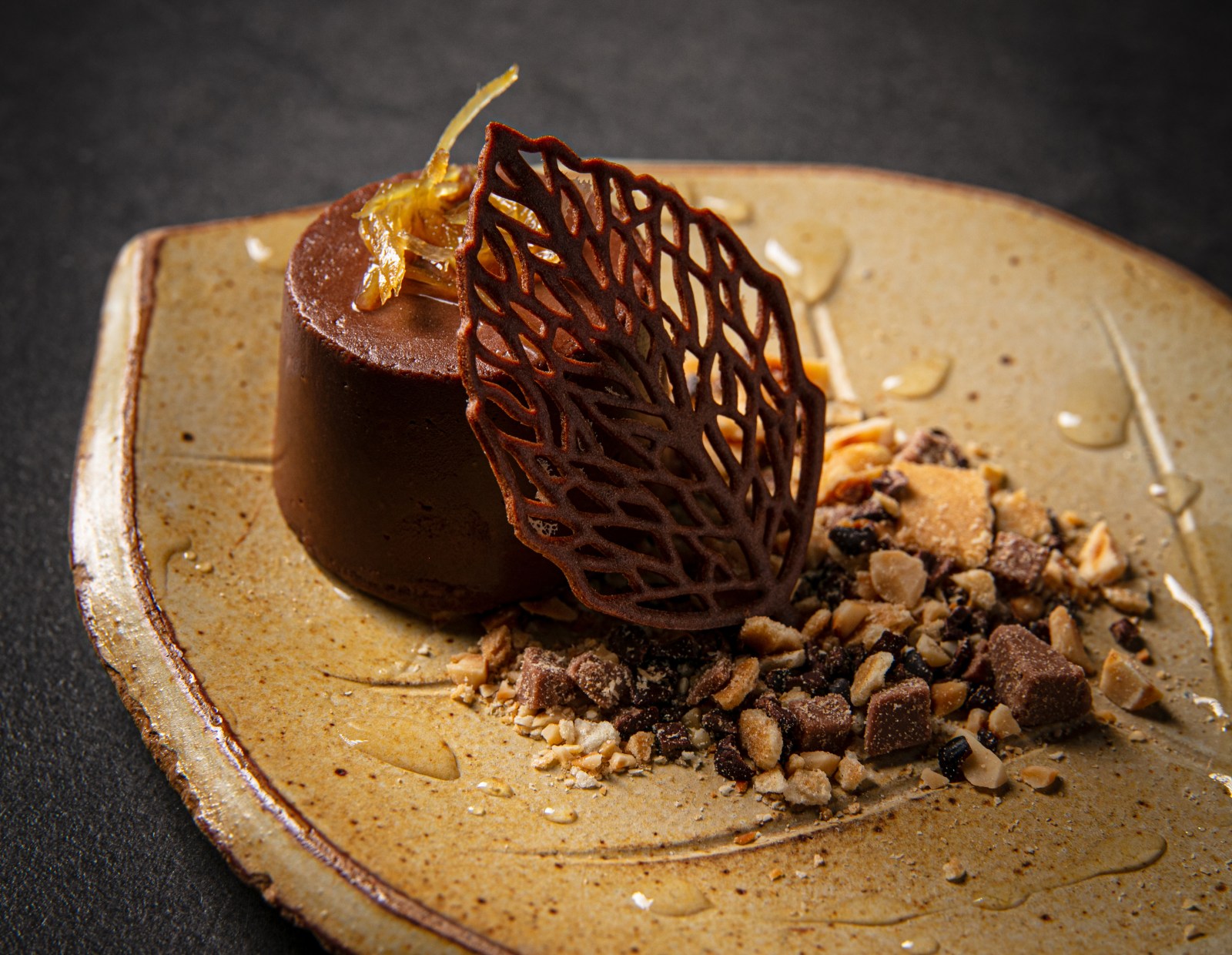
Chocolate cheesecake. (Photo: Supplied)
Kindly, they deliver small portions of a trio of desserts on one tray: chocolate cheesecake that looks like a chocolate truffle; mango and yuzu sherbet; and honeyed, lemony rooibos parfait. There is a final parting shot of proffered mochi mochi bonbon. I choose a peppermint crisp one;I can’t think what possessed me. These chewy mochi mochi sticky rice sweets are as squishy as their name suggests, but they don’t belong at the end of a meal of this out-of-this-world calibre.
But it is all the other flavours that linger on my tongue as we weave through the city in an Uber back to the ship.
Coda
There are many great restaurants in Cape Town. Some of those in the top echelon serve spectacular food but do not escape the problem of being somehow formulaic: a bar is set, styles of cooking are chosen and perfected; standards are applied to many of these across the board, and the rules must be followed. FYN stands apart from all of that. Peter Tempelhoff has always created fabulous food that looks good and always tastes even better than it looks. His cuisine is flawless. He does not need bars to be set or formulas to be put in place. He simply has no match – in Cape Town. But how does FYN compare to Durban’s finest? We’re heading there to find out. DM
The pairing menu wines for the FYN lunch:
Van Wyk Family Wines ‘Rachel Rose’ 2022, Western Cape
Mooiplaas Chenin Blanc 2011, Stellenbosch
Karakuchi ‘Suishin’ Sake, Hiroshima
Lourens Family Wines ‘Lindi Carien’ 2022, Western Cape
Simelia ‘Fluvius’ Merlot Magnum 2016, Wellington or The High Road ‘Director’s Reserve’ 2013, Stellenbosch
Daschbosch ‘Gevonden Hanepoot’ Muscat d’Alexandrie 2017, Breede River Valley






 Become an Insider
Become an Insider
Sounds fabulous. But how much does a feast like that cost?